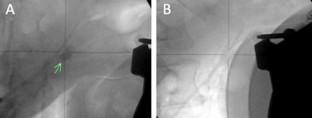Surgical Endoscopy ( IF 2.4 ) Pub Date : 2023-10-05 , DOI: 10.1007/s00464-023-10467-2
Nasir Saleem 1 , Feenalie Patel 1 , James L Watkins 1 , Lee McHenry 1 , Jeffrey J Easler 1 , Evan L Fogel 1 , Mark A Gromski 1 , Glen A Lehman 1 , Stuart Sherman 1 , Yan Tong 2 , Benjamin L Bick 1

|
Background and aims
Extracorporeal shock wave lithotripsy (ESWL) is performed to fragment large main pancreatic duct (MPD) stones in symptomatic patients. Subsequent endoscopic retrograde cholangiopancreatography (ERCP) is often performed to clear the stone fragments. Edema of surrounding tissue after ESWL theoretically affects the ability to perform ERCP. However, the optimal timing of ERCP after ESWL is not clearly defined. The aim of this study is to determine the efficacy and safety of same-day ERCP after ESWL and to determine if the timing of ERCP after ESWL affects outcomes.
Methods
This is a retrospective study of consecutive patients from January, 2013 to September, 2019 who received ESWL for MPD stones at our center. Included patients received subsequent same-day ERCP under the same general anesthesia session or later session ERCP (1–30 days after ESWL). Demographics, anatomical findings, history, and outcomes were collected. Success was defined as complete or near complete (> 80%) stone fragmentation with clearance.
Results
218 patients were treated with ESWL and subsequent ERCP. 133 (61.0%) received ERCP on the same day immediately after ESWL, while 85 (39.0%) returned for ERCP at a later day (median 3.0 days after ESWL). Baseline characteristics demonstrated patients who received same-day ERCP had a higher rate of pain at baseline (94.7% vs 87.1%, p = 0.045). Main outcomes demonstrated an overall successful MPD stone clearance rate of 90.4%, with similar rates between same-day ERCP and later session ERCP (91.7% vs 88.2%, p = 0.394). Additionally, successful cannulation at ERCP, adverse events, and post-procedure admission rates were similar.
Conclusions
Delaying ERCP to allow peripancreatic tissue recovery after ESWL does not affect outcomes. Same-day ERCP after ESWL is safe and effective.
中文翻译:

大型主胰管结石体外冲击波碎石术后 ERCP 时机
背景和目标
对有症状的患者进行体外冲击波碎石术 (ESWL),以碎裂大的主胰管 (MPD) 结石。随后通常进行内镜逆行胰胆管造影(ERCP)以清除结石碎片。 ESWL 后周围组织水肿理论上会影响进行 ERCP 的能力。然而,ESWL 后 ERCP 的最佳时机尚无明确定义。本研究的目的是确定 ESWL 后当天 ERCP 的有效性和安全性,并确定 ESWL 后 ERCP 的时间是否会影响结果。
方法
这是一项对2013年1月至2019年9月在我中心因MPD结石接受ESWL的连续患者的回顾性研究。纳入的患者在相同的全身麻醉下接受随后的当天 ERCP 或稍后的 ERCP(ESWL 后 1-30 天)。收集了人口统计数据、解剖学发现、病史和结果。成功的定义是完全或接近完全(> 80%)结石破碎并有间隙。
结果
218 名患者接受了 ESWL 和随后的 ERCP 治疗。 133 名 (61.0%) 人在 ESWL 后立即接受了 ERCP,而 85 名 (39.0%) 人在稍后一天(ESWL 后中位 3.0 天)返回接受 ERCP。基线特征表明,当天接受 ERCP 的患者基线时疼痛发生率较高(94.7% vs 87.1%, p = 0.045)。主要结果表明,MPD 结石清除率总体成功率为 90.4%,当天 ERCP 和后期 ERCP 之间的清除率相似(91.7% vs 88.2%, p = 0.394)。此外,ERCP 插管成功率、不良事件和术后入院率相似。
结论
延迟 ERCP 以允许 ESWL 后胰周组织恢复不会影响结果。 ESWL 后当天进行 ERCP 安全有效。

































 京公网安备 11010802027423号
京公网安备 11010802027423号